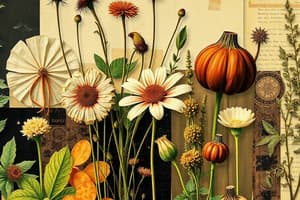Podcast
Questions and Answers
What do we get from the pulp of bamboo trees?
What do we get from the pulp of bamboo trees?
- Rope
- Medicine
- Paper (correct)
- Fabric
Which plant provides fibres used for making clothes and bags?
Which plant provides fibres used for making clothes and bags?
- Bamboo
- Coconut
- Jute
- Cotton (correct)
What is the source of rubber?
What is the source of rubber?
- Teak tree
- Aloe vera
- Rubber tree (correct)
- Pine tree
Which part of the plant provides resin used in paints?
Which part of the plant provides resin used in paints?
What is compost made from?
What is compost made from?
Flashcards
Bamboo Pulp
Bamboo Pulp
Paper is derived from the pulp of bamboo trees.
Cotton Fibers
Cotton Fibers
Cotton plants provide fibers used for making clothes and bags.
Source of Rubber
Source of Rubber
Rubber is sourced from the rubber tree.
Pine Tree Resin
Pine Tree Resin
Signup and view all the flashcards
Compost Material
Compost Material
Signup and view all the flashcards
Study Notes
Bamboo Pulp
- Bamboo pulp is derived from the inner tissues of bamboo trees, utilized for making paper and biodegradable products.
- It serves as a sustainable alternative to traditional wood pulp due to bamboo's rapid growth and renewability.
Plant Fibres for Textiles
- Cotton is the primary plant associated with fibres used for making clothes and bags, known for its softness and breathability.
- Other plants like hemp and flax also provide fibres that are used in textiles, offering strength and durability.
Source of Rubber
- Rubber is obtained from the latex of rubber trees, primarily the Hevea brasiliensis species.
- The latex is harvested through a process called tapping, which involves making incisions in the bark to collect the milky fluid.
Plant Part for Resin
- The resin used in paints is sourced from the bark of specific trees, particularly pine trees.
- This natural substance acts as a binding agent and provides water resistance and durability to paint products.
Compost Composition
- Compost is made from organic materials such as kitchen scraps, yard waste, and other biodegradable materials.
- The decomposition process transforms these materials into nutrient-rich soil amendments that enhance plant growth.
Studying That Suits You
Use AI to generate personalized quizzes and flashcards to suit your learning preferences.




